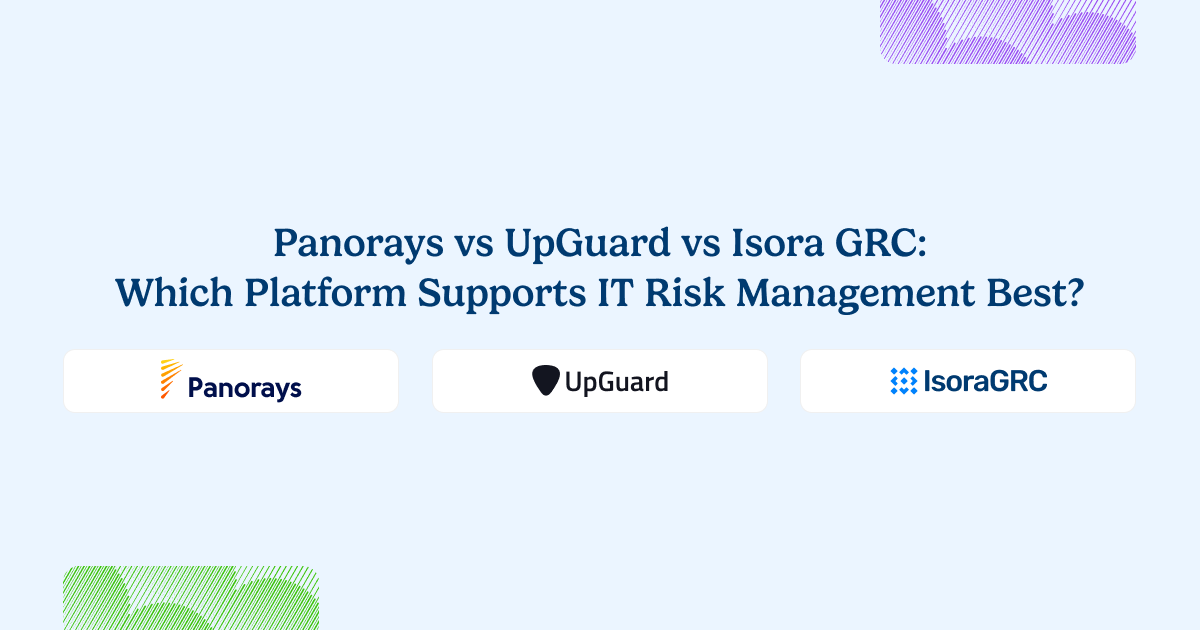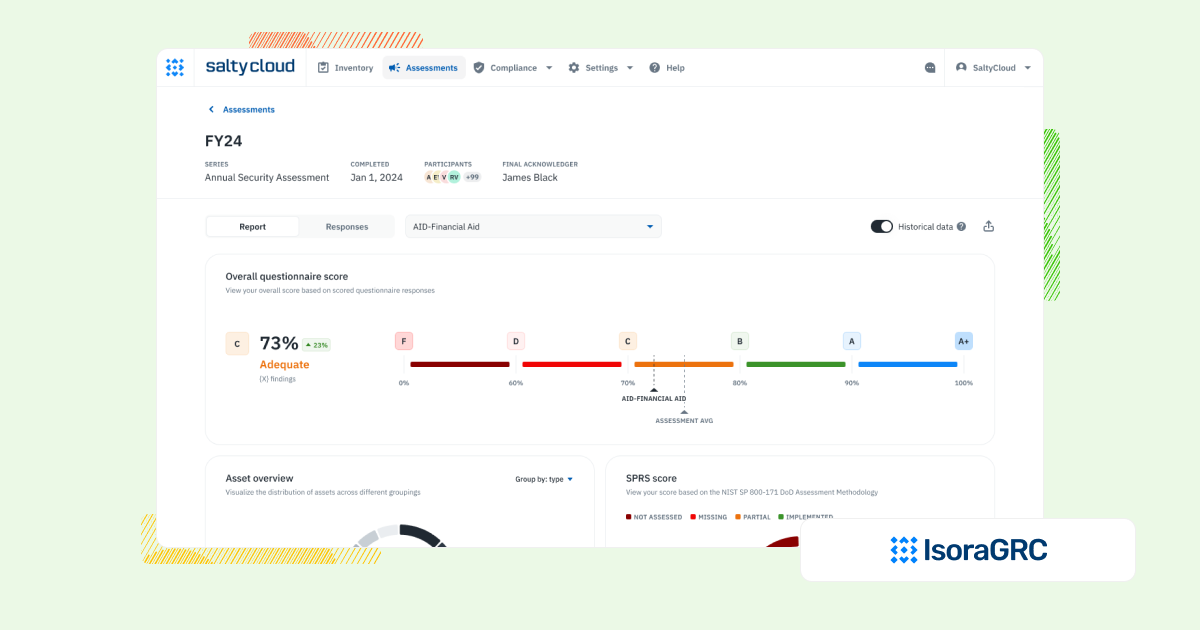
Every security team needs a comprehensive, scalable way to manage IT risk—not just monitor external vendor scores.
Platforms like Panorays and UpGuard specialize in vendor intelligence, providing external ratings to flag potential risks across your supply chain and third-party vendors.
External scores can highlight issues, but they don’t help you assess, track, or resolve risks in a structured, actionable way.
Isora GRC takes a more tailored route. It’s purpose-built for security teams who need to run assessments, manage inventories, and track risks—moving beyond external ratings to offer full-scale risk management.
Let’s zoom in on this.
Choosing the Right Platform for IT Risk Management
Panorays and UpGuard help organizations get visibility into vendor risk posture, but their utility stops at the insight. They don’t provide structured workflows to assess vendors in detail, manage exceptions, or align vendor risk findings with internal business processes.
Isora GRC helps you run real-world vendor risk assessments—mapped to the data types, systems, and stakeholders that matter most. It’s built for security teams who need to understand risk in context, resolve issues efficiently, and maintain visibility across a growing vendor ecosystem.
The Workflow That Matters: Managing IT Risks and Compliance
Modern vendor risk management involves more than scanning or collecting docs. Teams need to issue targeted assessments, review responses, handle flagged risks, and maintain vendor accountability across cycles and frameworks.
Isora GRC makes this easy to manage. With templated assessments, linked inventories, role-based collaboration, and built-in exception tracking, you can move from reactive reviews to proactive risk governance—without adding complexity.
How Each Platform Supports IT Risk Management Workflows
| Workflow Area | Panorays | UpGuard | Isora GRC |
| Assessment Management | Panorays automates third-party assessments well. It’s strong for security questionnaires, but some users say internal tracking and custom assessments feel clunky. | UpGuard offers strong tools for assessments, security ratings, and leak detection. Still, some users say it takes time to learn the platform. | Centralized, intuitive assessment dashboard across business units, vendors, and assets. Built specifically for security teams. |
| Questionnaire Delivery & Completion | The platform shines in vendor questionnaires with automated reminders and scoring. Still, users report that customization beyond templates can be limited without support help. | The system handles questionnaires well. But users wanting deep customization might feel limited. | Customizable and prebuilt questionnaires for frameworks like NIST, ISO, GLBA, HIPAA, and more. Designed for internal and external collaboration. |
| Inventory Tracking | Vendor inventory updates automatically, which users like. But tracking internal assets or deeper relationships between vendors and assets needs more manual setup. | UpGuard checks vendors and their security levels. Still, full asset tracking is not the main focus. | Centralized tracking of assets, vendors, and organizational units with integration support for existing data sources. |
| Risk Register & Exception Management | Panorays ties risks to vendors cleanly, but broader risk management feels secondary. Exception tracking is basic and often handled outside the platform. | Risk tools exist, but advanced features may need expert help. Less technical users could struggle. | Flexible, collaborative risk register with scoring, status, evidence, and ownership tied directly to assessments. Exception management is built-in and intuitive—no extra modules or configuration required. |
| Scoring, Reporting & Risk Visualization | Vendor risk scoring is clear and easy to follow. Still, some users want more customizable risk models and stronger visual reports for executive presentations. | UpGuard includes security scores and reports. However, risk visuals may feel basic to some users. | Automated scorecards, risk maps, and executive-friendly reports with actionable insights—no manual config required. |
| Collaboration & User Experience | User interface feels modern and responsive. Teams can review vendors quickly, but real collaboration—like shared editing or threaded discussions—is limited. | The platform works well for tech users. But learning to use the collaboration tools may take time. | WCAG-compliant, award-nominated interface with built-in commenting, team workflows, and fast onboarding. |
| Implementation & Setup | Setup moves quickly with out-of-the-box templates. Users say custom onboarding for specific needs takes more time and often needs Panorays’ services team to assist. | UpGuard needs time and resources to set up. Teams may need training and support for smooth use. | No-code setup in days or weeks. Minimal IT lift required. Designed to go live quickly across teams and vendors. |
What Sets Isora GRC Apart?

Isora GRC was purpose-built for information security teams—designed to support the real workflows behind risk and compliance, not just generate reports. While legacy GRC platforms require months of configuration and rigid processes, Isora takes a modern, scalable approach:
- Purpose-built for security and third-party risk teams
- No extra modules or cross-department bloat—just the workflows that matter.
- Easy for anyone to use
- Clean UI, no complex training, and built to drive adoption across the org.
- Streamlined for action, not just documentation
- Assessments, questionnaires, inventories, risk tracking, and reporting—all in one place.
- Fast, no-code implementation
- Go live in weeks, not quarters, with minimal IT lift.
- Scales with your program
- Whether you’re running a lean risk function or supporting a large institution, Isora grows with you—without getting in the way.
Who Each Platform Is Best For
| Platform | Who It’s For |
| Panorays | Basic vendor checks with some automation. Still needs a stronger platform to connect it all. |
| UpGuard | Getting a quick view of vendor security from the outside. Helpful info, but not a full-risk solution. |
| Isora GRC | Security teams that need a scalable, usable IT risk management program across their organization. |
What Our Customers Say About Isora GRC
Security teams at top institutions are using Isora GRC to replace legacy tools and manual processes with intuitive workflows and actionable insight.
“Moving from manual processes to using Isora was a breath of fresh air. What used to take months is now automated, reliable, and defensible. Isora saves us significant time while delivering accurate insights that improve decision-making.”
Jessica Sandy, IT GRC Manager, The University of Chicago
“Isora has been essential in helping us meet our University of California cybersecurity requirements across a decentralized campus. Automating assessment data collection and reporting has given us clear visibility into unit-level risks, enabling us to prioritize resources effectively and address gaps with confidence.”
Allison Henry, CISO, The University of California, Berkeley
FAQs
What’s the difference between Panorays, UpGuard, and Isora GRC?
Panorays and UpGuard focus on external vendor risk monitoring and automated security ratings. Isora GRC is built for active vendor risk management—enabling teams to issue assessments, track exceptions, manage vendor inventories, and document risk decisions collaboratively.
Are Panorays and UpGuard considered vendor risk management platforms?
They’re better classified as vendor intelligence tools. They provide external signals, but don’t offer the full workflows needed to conduct internal reviews, manage risk registers, or engage vendors directly in remediation efforts.
Does Isora GRC replace platforms like Panorays or UpGuard?
Yes, for organizations that want to go beyond passive monitoring. Isora GRC supports structured vendor assessments (e.g., HECVAT, SIG, CAIQ), internal review processes, and ongoing risk tracking.
Which platform is better for managing third-party risk across the organization?
Isora GRC. While Panorays and UpGuard provide useful external insights, Isora GRC gives teams the tools to evaluate vendors directly, request evidence, resolve exceptions, and maintain accountability across departments.
Can Isora GRC be used alongside Panorays or UpGuard?
Yes. Some organizations use Panorays or UpGuard for continuous monitoring and combine them with Isora GRC for operational workflows like assessments, documentation, and follow-up tracking.
What should I look for in a vendor risk platform that goes beyond scores?
Look for workflow coverage: customizable questionnaires, vendor engagement, exception tracking, and centralized risk reporting. Isora GRC enables teams to manage the full third-party risk lifecycle—not just monitor it.


















